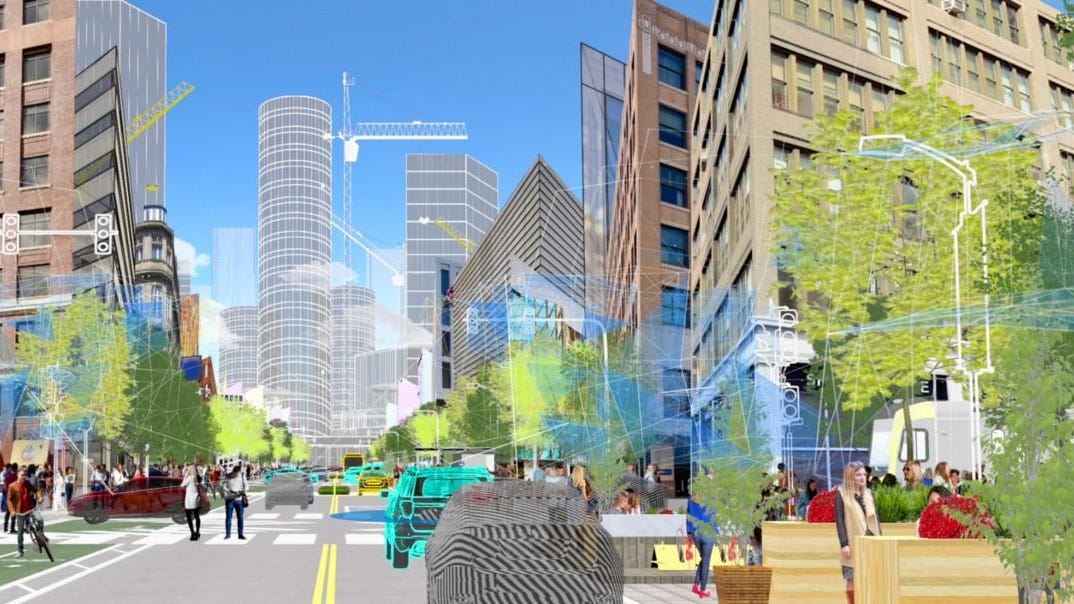Ford’s plan for a ‘smart city’: Join transit cloud
Las Vegas — Facing pressure to demonstrate Ford Motor Co.’s efforts to step into the future, CEO Jim Hackett used the CES technology show to introduce an ambitious cloud-based platform that’s intended not just to coordinate transportation, but to transform whole cities.

“The time we used to spend with each other is now time wasted in traffic and congestion,” Hackett said in a presentation Tuesday. “We’re just beginning to understand what the tech will allow. ... I need you to be excited to work with us.”
The automaker’s network of technologies will live inside the so-called Transportation Mobility Cloud the Blue Oval is developing with Silicon Valley start-up Autonomic. The companies are offering it as a framework for cities to create systems in which every piece of technology — from buses and self-driving cars, to the infrastructure of the traffic system itself — speaks the same language. By doing so, Ford says cities can reduce traffic congestion and parking problems, and allow millions of people to move into city centers.
The Dearborn-based automaker invited everyone from cities to app developers and other automakers to join it in developing the technology. The open-cloud platform is designed to act as a base upon which other companies can build their own systems.
Wall Street didn’t seem to be impressed: Ford stock closed Tuesday down 0.4 percent on a day when the Dow was up 0.5 percent. While the company’s groundwork for what it calls the “City of Tomorrow” crystallizes a plan of action, Edmunds automotive analyst Jessica Caldwell believes it may not be enough.
“Ford’s vision for the smart city is an interesting premise, but at this point it’s not much more than that,” Caldwell said after the presentation. “It’s admirable that Ford is taking a philosophical approach and is looking at how connected vehicles can change society for the better — however, this future is a long way off. In the meantime, Ford has an opportunity to better articulate how they’re going to improve the lives of car shoppers today.”
Version already exists
Marcy Klevorn, Ford’s president of smart mobility, said a version of the Transportation Mobility Cloud already exists. She said the automaker is using it to manage its Chariot shuttle fleets in San Francisco and New York.
“We’re using it ourselves, so we had the idea of ‘Why don’t we open it up to everybody and let them enjoy the same speed and the same efficiency that we’re enjoying?’ ” Klevorn said in an interview in Las Vegas. “If you think about the challenges of a city, it’s an ecosystem challenge. No one company or provider is going to solve all of the challenges a city has. ... I guess maybe we’re the first ones thinking about it openly and more inclusively.”
How Ford will make money off this mobility platform is not completely clear. Klevorn said a subscription-based model for cities or private and municipal transit operations could be realistic, as could the monetizing of data. Ford would sell access to the platform to interested users, mostly other businesses.
As more partners patch into Ford’s grid — which will eventually be powered by a cellular data-sharing technology developed with telecommunications company Qualcomm Technologies — the automaker would use that information to hone its own self-driving business model.
Much of this technology, like cellular data-sharing that would eventually power Ford’s mobility grid, is highly sophisticated. It’s certainly not common in U.S. cities.
Jim Farley, who heads up global markets for the automaker, said Ford is gearing up to test its robotic cars. The automaker has chosen a city to test both its self-driving cars and the proposed cloud-based business model, but has not disclosed that location. Each of those driverless cars will be connected to Ford’s cloud, allowing partners like Lyft to manage self-driving fleets.
Postmates, an on-demand delivery service, will also begin conducting self-driving pilots with Ford this year to see how the technology could improve delivery and reach new customers, Sherif Marakby, Ford’s vice president of autonomous vehicles and electrification, wrote in a blog post Tuesday.
And Ford will build those automated vehicles from the ground up, Farley said.
“We don’t believe in converting a vehicle,” he said. “We believe at Ford we need to design a vehicle that is all-new, just for autonomy use.”
Farley emphasized Ford’s strength in developing vehicles for heavy-duty use in taxi fleets and police, which could mean the robot vehicles will be some kind of SUV or van — not a sedan, like the Fusions they have used as a test bed.
The company has said such a vehicle would be a hybrid-electric. The company is focusing initially on establishing a commercial fleet that can run for long hours and haul goods.
Ford’s vision cloudy
Ford’s Transportation Mobility Cloud plan raises as many questions as it answers, said Karl Brauer, an analyst with Cox Automotive.
“On one hand, I would expect to see more evidence of hardware progress from Ford, since that should be their strong point and we’re seeing more advanced autonomous vehicles from other automakers,” he said. “Hackett’s comments confirm Ford is focused on those areas, but so are plenty of other automakers.”
Brauer said that Ford’s ideas are good ones, and if it can establish a standardized communication protocol, it could solve the vehicle-to-vehicle and vehicle-to-infrastructure questions that would need to be resolved.
“Does Ford have an advantage in this area that makes up for any disadvantage it suffers in AV hardware?” he asked. “Hard to tell at this point.”
Detroit News Staff Writer Ian Thibodeau contributed.